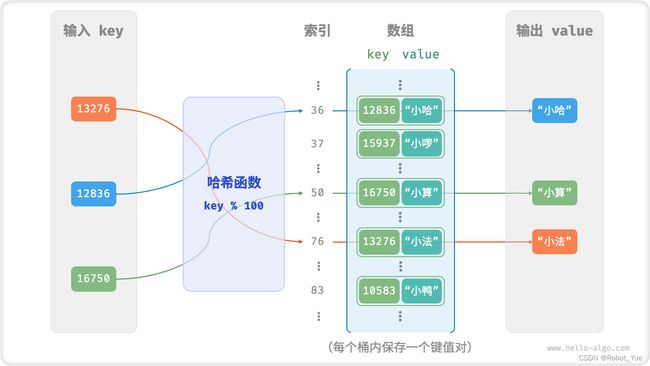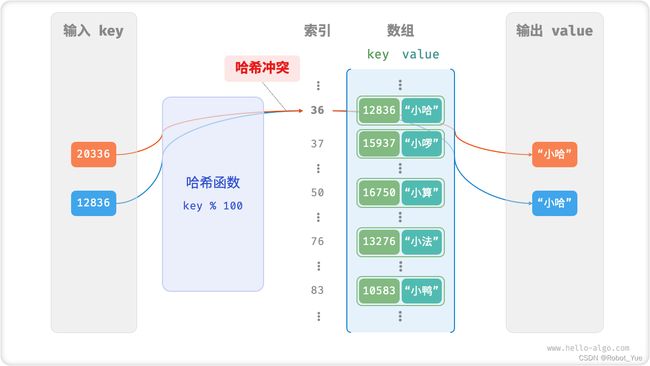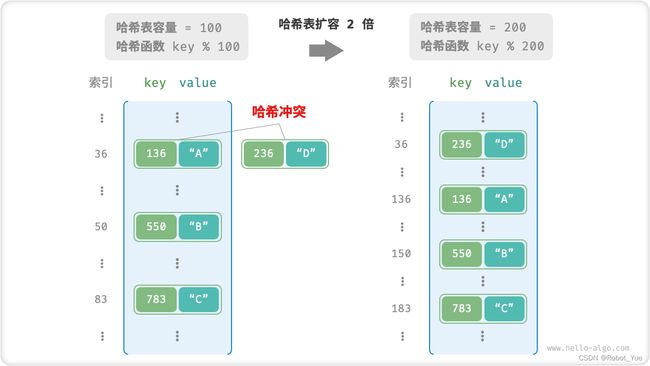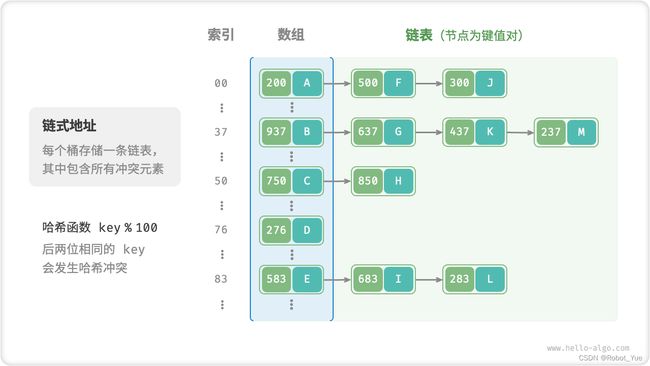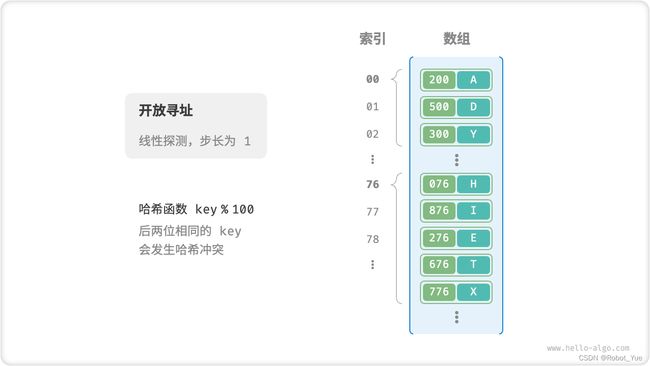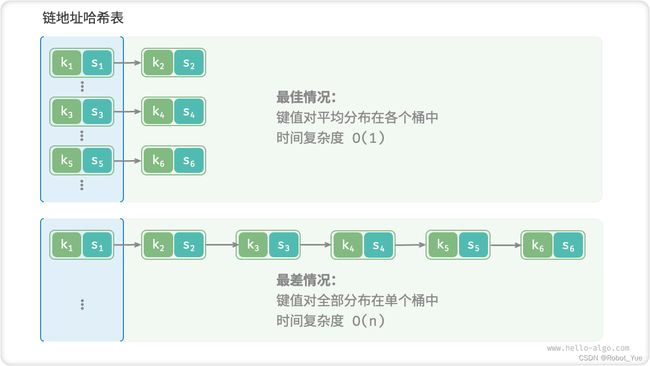数据结构与算法(四):哈希表
参考引用
- Hello 算法
- Github:hello-algo
1. 哈希表
1.1 哈希表概述
-
哈希表(hash table),又称散列表,其通过建立键 key 与值 value 之间的映射,实现高效的元素查询
- 具体而言,向哈希表输入一个键 key ,则可以在 O(1) 时间内获取对应的值 value
-
如下图所示,给定 n 个学生,每个学生都有 “姓名” 和 “学号” 两项数据。假如希望实现 “输入一个学号,返回对应的姓名” 的查询功能,则可以采用下图所示的哈希表来实现
- 除哈希表外,数组和链表也可以实现查询功能,它们的效率对比如下图所示
- 在哈希表中进行增删查改的时间复杂度都是 O(1),非常高效
1.2 哈希表常用操作
- 哈希表的常见操作包括:初始化、查询操作、添加键值对和删除键值对等
/* 1、初始化哈希表 */
unordered_map<int, string> map;
/* 2、添加操作 */
// 在哈希表中添加键值对 (key, value)
map[12836] = "小哈";
map[15937] = "小啰";
map[16750] = "小算";
map[13276] = "小法";
map[10583] = "小鸭";
/* 3、查询操作 */
// 向哈希表输入键 key ,得到值 value
string name = map[15937];
/* 4、删除操作 */
// 在哈希表中删除键值对 (key, value)
map.erase(10583);
- 哈希表有三种常用遍历方式:遍历键值对、遍历键和遍历值
/* 5、遍历哈希表 */ // 遍历键值对 key->value for (auto kv: map) { cout << kv.first << " -> " << kv.second << endl; } // 单独遍历键 key for (auto kv: map) { cout << kv.first << endl; } // 单独遍历值 value for (auto kv: map) { cout << kv.second << endl; }
1.3 哈希表简单实现
基于数组实现哈希表
- 在哈希表中,将数组中的每个空位称为桶(bucket),每个桶可存储一个键值对。因此,查询操作就是找到 key 对应的桶,并在桶中获取 value。如何基于 key 来定位对应的桶呢?通过哈希函数(hash function)实现
- 哈希函数的作用:将一个较大的输入空间映射到一个较小的输出空间
- 在哈希表中,输入空间是所有 key,输出空间是所有桶(数组索引)。换句话说,输入一个 key,可以通过哈希函数得到该 key 对应的键值对在数组中的存储位置
- 输入一个 key,哈希函数的计算过程分为以下两步
- 通过某种哈希算法 hash() 计算得到哈希值
- 将哈希值对桶数量(数组长度,capacity)取模,从而获取该 key 对应的数组索引 index
index = hash(key) % capacity - 随后,就可以利用 index 在哈希表中访问对应的桶,从而获取 value。设数组长度 capacity = 100、哈希算法 hash(key) = key,易得哈希函数为 key % 100。下图以 key 学号和 value 姓名为例,展示了哈希函数的工作原理
/* 键值对 */
struct Pair {
public:
int key;
string val;
Pair(int key, string val) {
// 使用 this 指针来引用当前对象的成员变量,将传入的参数赋值给成员变量 key 和 val
this->key = key;
this->val = val;
}
};
/* 基于数组简易实现的哈希表 */
class ArrayHashMap {
private:
vector<Pair *> buckets;
public:
ArrayHashMap() {
// 初始化数组,包含 100 个桶
buckets = vector<Pair *>(100);
}
~ArrayHashMap() {
// 释放内存
for (const auto &bucket : buckets) {
delete bucket;
}
buckets.clear();
}
/* 哈希函数 */
int hashFunc(int key) {
int index = key % 100;
return index;
}
/* 查询操作 */
string get(int key) {
int index = hashFunc(key);
Pair *pair = buckets[index];
if (pair == nullptr)
return "";
return pair->val;
}
/* 添加操作 */
void put(int key, string val) {
Pair *pair = new Pair(key, val);
int index = hashFunc(key);
buckets[index] = pair;
}
/* 删除操作 */
void remove(int key) {
int index = hashFunc(key);
// 释放内存并置为 nullptr
delete buckets[index];
buckets[index] = nullptr;
}
/* 获取所有键值对 */
vector<Pair *> pairSet() {
vector<Pair *> pairSet;
for (Pair *pair : buckets) {
if (pair != nullptr) {
pairSet.push_back(pair);
}
}
return pairSet;
}
/* 获取所有键 */
vector<int> keySet() {
vector<int> keySet;
for (Pair *pair : buckets) {
if (pair != nullptr) {
keySet.push_back(pair->key);
}
}
return keySet;
}
/* 获取所有值 */
vector<string> valueSet() {
vector<string> valueSet;
for (Pair *pair : buckets) {
if (pair != nullptr) {
valueSet.push_back(pair->val);
}
}
return valueSet;
}
/* 打印哈希表 */
void print() {
for (Pair *kv : pairSet()) {
cout << kv->key << " -> " << kv->val << endl;
}
}
};
1.4 哈希冲突与扩容
- 本质上看,哈希函数的作用是将所有 key 构成的输入空间映射到数组所有索引构成的输出空间,而输入空间往往远大于输出空间。因此,理论上一定存在 “多个输入对应相同输出” 的情况
- 对于上述示例中的哈希函数,当输入的 key 后两位相同时,哈希函数的输出结果也相同。例如,查询学号为 12836 和 20336 的两个学生时,得到
12836 % 100 = 36 20336 % 100 = 36 - 如下图所示,两个学号指向了同一个姓名,这显然是不对的。将这种多个输入对应同一输出的情况称为哈希冲突(hash collision)
- 容易想到,哈希表容量越大,多个 key 被分配到同一个桶中的概率就越低,冲突就越少。因此,可以通过扩容哈希表来减少哈希冲突。如下图所示,扩容前键值对 (136, A) 和 (236, D) 发生冲突,扩容后冲突消失
类似于数组扩容,哈希表扩容需将所有键值对从原哈希表迁移至新哈希表,非常耗时。并且由于哈希表容量 capacity 改变,需要通过哈希函数来重新计算所有键值对的存储位置,这进一步提高了扩容过程的计算开销。为此,通常会预留足够大的哈希表容量,防止频繁扩容
- 负载因子是哈希表的一个重要概念,其定义为哈希表的元素数量除以桶数量,用于衡量哈希冲突的严重程度,也常被作为哈希表扩容的触发条件
2. 哈希冲突
-
通常情况下哈希函数的输入空间远大于输出空间,因此理论上哈希冲突是不可避免的。比如,输入空间为全体整数,输出空间为数组容量大小,则必然有多个整数映射至同一桶索引
-
哈希冲突会导致查询结果错误,严重影响哈希表的可用性。为解决该问题,可以每当遇到哈希冲突时就进行哈希表扩容,直至冲突消失为止。此方法简单粗暴且有效,但效率太低,因为哈希表扩容需要进行大量的数据搬运与哈希值计算。为了提升效率,可以采用以下策略
- 改良哈希表数据结构,使得哈希表可以在存在哈希冲突时正常工作
- 仅在哈希冲突比较严重时,才执行扩容操作
哈希表的结构改良方法主要包括 “链式地址” 和 “开放寻址”
2.1 链式地址
- 在原始哈希表中,每个桶仅能存储一个键值对。链式地址(separate chaining)将单个元素转换为链表,将键值对作为链表节点,将所有发生冲突的键值对都存储在同一链表中。下图展示了一个链式地址哈希表的例子
-
基于链式地址实现的哈希表的操作方法发生了以下变化
- 查询元素
- 输入 key,经过哈希函数得到桶索引,即可访问链表头节点,然后遍历链表并对比 key 以查找目标键值对
- 添加元素
- 先通过哈希函数访问链表头节点,然后将节点(即键值对)添加到链表中
- 删除元素
- 根据哈希函数的结果访问链表头部,接着遍历链表以查找目标节点,并将其删除
- 查询元素
-
链式地址存在以下局限性
- 占用空间增大,链表包含节点指针,它相比数组更加耗费内存空间
- 查询效率降低,因为需要线性遍历链表来查找对应元素
/* 链式地址哈希表 */
class HashMapChaining {
private:
int size; // 键值对数量
int capacity; // 哈希表容量
double loadThres; // 触发扩容的负载因子阈值
int extendRatio; // 扩容倍数
vector<vector<Pair *>> buckets; // 桶数组
public:
/* 构造方法 */
HashMapChaining() : size(0), capacity(4), loadThres(2.0 / 3.0), extendRatio(2) {
buckets.resize(capacity);
}
/* 析构方法 */
~HashMapChaining() {
for (auto &bucket : buckets) {
for (Pair *pair : bucket) {
// 释放内存
delete pair;
}
}
}
/* 哈希函数 */
int hashFunc(int key) {
return key % capacity;
}
/* 负载因子 */
double loadFactor() {
return (double)size / (double)capacity;
}
/* 查询操作 */
string get(int key) {
int index = hashFunc(key);
// 遍历桶,若找到 key 则返回对应 val
for (Pair *pair : buckets[index]) {
if (pair->key == key) {
return pair->val;
}
}
// 若未找到 key 则返回空字符串
return "";
}
/* 添加操作 */
void put(int key, string val) {
// 当负载因子超过阈值时,执行扩容
if (loadFactor() > loadThres) {
extend();
}
int index = hashFunc(key);
// 遍历桶,若遇到指定 key ,则更新对应 val 并返回
for (Pair *pair : buckets[index]) {
if (pair->key == key) {
pair->val = val;
return;
}
}
// 若无该 key ,则将键值对添加至尾部
buckets[index].push_back(new Pair(key, val));
size++;
}
/* 删除操作 */
void remove(int key) {
int index = hashFunc(key);
auto &bucket = buckets[index];
// 遍历桶,从中删除键值对
for (int i = 0; i < bucket.size(); i++) {
if (bucket[i]->key == key) {
Pair *tmp = bucket[i];
bucket.erase(bucket.begin() + i); // 从中删除键值对
delete tmp; // 释放内存
size--;
return;
}
}
}
/* 扩容哈希表 */
void extend() {
// 暂存原哈希表
vector<vector<Pair *>> bucketsTmp = buckets;
// 初始化扩容后的新哈希表
capacity *= extendRatio;
buckets.clear();
buckets.resize(capacity);
size = 0;
// 将键值对从原哈希表搬运至新哈希表
for (auto &bucket : bucketsTmp) {
for (Pair *pair : bucket) {
put(pair->key, pair->val);
// 释放内存
delete pair;
}
}
}
/* 打印哈希表 */
void print() {
for (auto &bucket : buckets) {
cout << "[";
for (Pair *pair : bucket) {
cout << pair->key << " -> " << pair->val << ", ";
}
cout << "]\n";
}
}
};
当链表很长时,查询效率 O(n) 很差。此时可以将链表转换为 “AVL 树” 或 “红黑树”,从而将查询操作的时间复杂度优化至 O(log n)
2.2 开放寻址
- 开放寻址(open addressing)不引入额外的数据结构,而是通过 “多次探测” 来处理哈希冲突,探测方式主要包括线性探测、平方探测、多次哈希等
2.2.1 线性探测
-
线性探测采用固定步长的线性搜索来进行探测,其操作方法与普通哈希表有所不同
- 插入元素
- 通过哈希函数计算桶索引,若发现桶内已有元素,则从冲突位置向后线性遍历(步长通常为 1),直至找到空桶,将元素插入其中
- 查找元素
- 若发现哈希冲突,则使用相同步长向后线性遍历,直到找到对应元素,返回 value 即可
- 如果遇到空桶,说明目标元素不在哈希表中,返回 None
- 插入元素
-
下图展示了开放寻址(线性探测)哈希表的键值对分布。根据此哈希函数,最后两位相同的 key 都会被映射到相同的桶。而通过线性探测,它们被依次存储在该桶以及之下的桶中
- 然而,线性探测容易产生 “聚集现象”。具体来说,数组中连续被占用的位置越长,这些连续位置发生哈希冲突的可能性越大,从而进一步促使该位置的聚堆生长,形成恶性循环,最终导致增删查改操作效率劣化
- 不能在开放寻址哈希表中直接删除元素。这是因为删除元素会在数组内产生一个空桶 None,而当查询元素时,线性探测到该空桶就会返回,因此在该空桶之下的元素都无法再被访问到,程序可能误判这些元素不存在
-
为了解决该问题,可以采用懒删除(lazy deletion)机制
- 它不直接从哈希表中移除元素,而是利用一个常量 TOMBSTONE 来标记这个桶
- 在该机制下,None 和 TOMBSTONE 都代表空桶,都可以放置键值对
- 但不同的是,线性探测到 TOMBSTONE 时应该继续遍历,因为其之下可能还存在键值对
-
然而,懒删除可能会加速哈希表的性能退化。这是因为每次删除操作都会产生一个删除标记,随着 TOMBSTONE 的增加,搜索时间也会增加,因为线性探测可能需要跳过多个 TOMBSTONE 才能找到目标元素
- 为此,考虑在线性探测中记录遇到的首个 TOMBSTONE 的索引,并将搜索到的目标元素与该 TOMBSTONE 交换位置。这样做的好处是当每次查询或添加元素时,元素会被移动至距离理想位置(探测起始点)更近的桶,从而优化查询效率
-
以下代码实现了一个包含懒删除的开放寻址(线性探测)哈希表。为了更加充分地使用哈希表的空间,将哈希表看作是一个 “环形数组”,当越过数组尾部时,回到头部继续遍历
/* 开放寻址哈希表 */ class HashMapOpenAddressing { private: int size; // 键值对数量 int capacity = 4; // 哈希表容量 const double loadThres = 2.0 / 3.0; // 触发扩容的负载因子阈值 const int extendRatio = 2; // 扩容倍数 vector<Pair *> buckets; // 桶数组 Pair *TOMBSTONE = new Pair(-1, "-1"); // 删除标记 public: /* 构造方法 */ HashMapOpenAddressing() : size(0), buckets(capacity, nullptr) { } /* 析构方法 */ ~HashMapOpenAddressing() { for (Pair *pair : buckets) { if (pair != nullptr && pair != TOMBSTONE) { delete pair; } } delete TOMBSTONE; } /* 哈希函数 */ int hashFunc(int key) { return key % capacity; } /* 负载因子 */ double loadFactor() { return (double)size / capacity; } /* 搜索 key 对应的桶索引 */ int findBucket(int key) { int index = hashFunc(key); int firstTombstone = -1; // 线性探测,当遇到空桶时跳出 while (buckets[index] != nullptr) { // 若遇到 key ,返回对应桶索引 if (buckets[index]->key == key) { // 若之前遇到了删除标记,则将键值对移动至该索引 if (firstTombstone != -1) { buckets[firstTombstone] = buckets[index]; buckets[index] = TOMBSTONE; return firstTombstone; // 返回移动后的桶索引 } return index; // 返回桶索引 } // 记录遇到的首个删除标记 if (firstTombstone == -1 && buckets[index] == TOMBSTONE) { firstTombstone = index; } // 计算桶索引,越过尾部返回头部 index = (index + 1) % capacity; } // 若 key 不存在,则返回添加点的索引 return firstTombstone == -1 ? index : firstTombstone; } /* 查询操作 */ string get(int key) { // 搜索 key 对应的桶索引 int index = findBucket(key); // 若找到键值对,则返回对应 val if (buckets[index] != nullptr && buckets[index] != TOMBSTONE) { return buckets[index]->val; } // 若键值对不存在,则返回空字符串 return ""; } /* 添加操作 */ void put(int key, string val) { // 当负载因子超过阈值时,执行扩容 if (loadFactor() > loadThres) { extend(); } // 搜索 key 对应的桶索引 int index = findBucket(key); // 若找到键值对,则覆盖 val 并返回 if (buckets[index] != nullptr && buckets[index] != TOMBSTONE) { buckets[index]->val = val; return; } // 若键值对不存在,则添加该键值对 buckets[index] = new Pair(key, val); size++; } /* 删除操作 */ void remove(int key) { // 搜索 key 对应的桶索引 int index = findBucket(key); // 若找到键值对,则用删除标记覆盖它 if (buckets[index] != nullptr && buckets[index] != TOMBSTONE) { delete buckets[index]; buckets[index] = TOMBSTONE; size--; } } /* 扩容哈希表 */ void extend() { // 暂存原哈希表 vector<Pair *> bucketsTmp = buckets; // 初始化扩容后的新哈希表 capacity *= extendRatio; buckets = vector<Pair *>(capacity, nullptr); size = 0; // 将键值对从原哈希表搬运至新哈希表 for (Pair *pair : bucketsTmp) { if (pair != nullptr && pair != TOMBSTONE) { put(pair->key, pair->val); delete pair; } } } /* 打印哈希表 */ void print() { for (Pair *pair : buckets) { if (pair == nullptr) { cout << "nullptr" << endl; } else if (pair == TOMBSTONE) { cout << "TOMBSTONE" << endl; } else { cout << pair->key << " -> " << pair->val << endl; } } } };
2.2.2 平方探测
-
平方探测与线性探测类似,都是开放寻址的常见策略之一。当发生冲突时,平方探测不是简单地跳过一个固定的步数,而是跳过 “探测次数的平方” 的步数,即 1, 4, 9, … 步
-
平方探测优点
- 平方探测通过跳过平方的距离,试图缓解线性探测的聚集效应
- 平方探测会跳过更大的距离来寻找空位置,有助于数据分布得更加均匀
-
平方探测缺点
- 仍然存在聚集现象,即某些位置比其他位置更容易被占用
- 由于平方的增长,平方探测可能不会探测整个哈希表,这意味着即使哈希表中有空桶,平方探测也可能无法访问到它
2.2.3 多次哈希
- 多次哈希使用多个哈希函数 f_1(x)、f_2(x)、f_3(x)、… 进行探测
- 插入元素
- 若哈希函数 f_1(x) 出现冲突,则尝试 f_2(x),以此类推,直到找到空桶后插入元素
- 查找元素
- 在相同的哈希函数顺序下进行查找,直到找到目标元素时返回
- 或当遇到空桶或已尝试所有哈希函数,说明哈希表中不存在该元素,则返回 None
- 插入元素
与线性探测相比,多次哈希方法不易产生聚集,但多个哈希函数会增加额外的计算量
3. 哈希算法
无论是开放寻址还是链地址法,它们只能保证哈希表可以在发生冲突时正常工作,但无法减少哈希冲突的发生
- 如果哈希冲突过于频繁,哈希表的性能则会急剧劣化。如下图所示,对于链地址哈希表,理想情况下键值对平均分布在各个桶中,达到最佳查询效率;最差情况下所有键值对都被存储到同一个桶中,时间复杂度退化至 O(n)
- 键值对的分布情况由哈希函数决定
index = hash(key) % capacity // 哈希函数- 当哈希表容量 capacity 固定时,哈希算法 hash() 决定了输出值,进而决定了键值对在哈希表中的分布情况。这意味着,为了减小哈希冲突的发生概率,应当将注意力集中在哈希算法 hash() 的设计上
3.1 哈希算法的设计
- 加法哈希
- 对输入的每个字符的 ASCII 码进行相加,将得到的总和作为哈希值
- 乘法哈希
- 利用了乘法的不相关性,每轮乘以一个常数,将各个字符的 ASCII 码累积到哈希值中
- 异或哈希
- 将输入数据的每个元素通过异或操作累积到一个哈希值中
- 旋转哈希
- 将每个字符的 ASCII 码累积到一个哈希值中,每次累积之前都会对哈希值进行旋转操作
/* 加法哈希 */ int addHash(string key) { long long hash = 0; const int MODULUS = 1000000007; for (unsigned char c : key) { hash = (hash + (int)c) % MODULUS; } return (int)hash; } /* 乘法哈希 */ int mulHash(string key) { long long hash = 0; const int MODULUS = 1000000007; for (unsigned char c : key) { hash = (31 * hash + (int)c) % MODULUS; } return (int)hash; } /* 异或哈希 */ int xorHash(string key) { int hash = 0; const int MODULUS = 1000000007; for (unsigned char c : key) { hash ^= (int)c; } return hash & MODULUS; } /* 旋转哈希 */ int rotHash(string key) { long long hash = 0; const int MODULUS = 1000000007; for (unsigned char c : key) { hash = ((hash << 4) ^ (hash >> 28) ^ (int)c) % MODULUS; } return (int)hash; } - 每种哈希算法的最后一步都是对大质数 1000000007 取模,以确保哈希值在合适的范围内。值得思考的是,为什么要强调对质数取模,或者说对合数取模的弊端是什么?
- 当使用大质数作为模数时,可以最大化地保证哈希值的均匀分布。因为质数不会与其他数字存在公约数,可以减少因取模操作而产生的周期性模式,从而避免哈希冲突
- 通常选取质数作为模数,并且这个质数最好足够大,以尽可能消除周期性模式,提升哈希算法的稳健性
3.2 常见哈希算法
上述简单哈希算法比较脆弱,比如:由于加法和异或满足交换律,因此加法哈希和异或哈希无法区分内容相同但顺序不同的字符串,这可能会加剧哈希冲突,并引起一些安全问题
- 在实际中,通常会用一些标准哈希算法,例如 MD5、SHA-1、SHA-2、SHA3 等。它们可以将任意长度的输入数据映射到恒定长度的哈希值
- MD5 和 SHA-1 已多次被成功攻击,因此它们被各类安全应用弃用
- SHA-2 系列中的 SHA-256 是最安全的哈希算法之一,仍未出现成功的攻击案例,因此常被用在各类安全应用与协议中
- SHA-3 相较 SHA-2 的实现开销更低、计算效率更高,但目前使用覆盖度不如 SHA-2 系列
3.3 数据结构的哈希值
-
哈希表的 key 可以是整数、小数或字符串等数据类型。编程语言通常会为这些数据类型提供内置的哈希算法,用于计算哈希表中的桶索引
int num = 3; size_t hashNum = hash<int>()(num); // 整数 3 的哈希值为 3 bool bol = true; size_t hashBol = hash<bool>()(bol); // 布尔量 1 的哈希值为 1 double dec = 3.14159; size_t hashDec = hash<double>()(dec); // 小数 3.14159 的哈希值为 4614256650576692846 string str = "Hello 算法"; size_t hashStr = hash<string>()(str); // 字符串 Hello 算法 的哈希值为 15466937326284535026 // 在 C++ 中,内置 std:hash() 仅提供基本数据类型的哈希值计算 // 数组、对象的哈希值计算需要自行实现 -
在许多编程语言中,只有不可变对象才可作为哈希表的 key。假如将列表(动态数组)作为 key ,当列表的内容发生变化时,它的哈希值也随之改变,就无法在哈希表中查询到原先的 value
-
虽然自定义对象(比如链表节点)的成员变量是可变的,但它是可哈希的。这是因为对象的哈希值通常是基于内存地址生成的,即使对象的内容发生了变化,但它的内存地址不变,哈希值仍然是不变的


